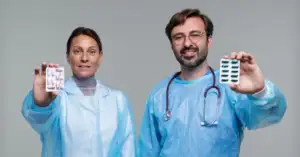The ability of the drug substance to pass through the skin into the blood circulation is known as percutaneous absorption. This is an alternative path for the drug delivery that have the probability of deactivation by gastric juices. It also efficiently delivers extremely minute quantities of drug substances along with drugs which can be effortlessly transported to the target organs lying in proximity for delivering percutaneously. In the technology of pharmaceuticals advancement, transdermal dosage forms play a significant role, presenting a drug delivery method which is non-invasive and convenient. These formulations are innovative in nature and designed to deliver medications through the skin, providing a drug release in a controlled and sustained release into the bloodstream. Transdermal patches, creams, gels, and ointments are amongst the several forms used for delivering a vast medications range, from relievers of pain to hormone therapies. The fascination of transdermal dosage forms lies in their capability of bypassing gastrointestinal tract thereby preventing first-pass effect and also propensity for reduced side-effects unlike the oral dosing of the medicine.
Pharmaceutical manufacturers involved in the novel drug delivery systems are important stakeholders in developing and producing these transdermal dosage forms, ensuring they are formulated, packaged, and labeled correctly. R&D is conducted extensively by pharmaceutical manufacturers for the effective and safe creation of these products meeting demands of the market and regulatory standards. Studies of these dosage forms may be included in global clinical trials for their safety and efficacy assessment in varied populations across distinctive regions worldwide. Global clinical trials often involve evaluating these transdermal dosage forms in various countries to gather data on their efficacy, safety, local tolerance and its clinical acceptability in different ethnicities and environmental conditions.
Here are some common types of transdermal dosage forms:
- Transdermal Patches: Among the transdermal dosage forms these are the most usual ones. They consist of a backing layer, a reservoir for the drug, an adhesive layer, and a release liner. The reservoir contains a drug which diffuses slowly through the skin into the stream of blood over a stipulated time. Examples include nicotine patches, hormonal replacement therapy, and management of pain (e.g., fentanyl patches).
- Transdermal Gels: Formulations in semisolid containing the drug are termed as gels. On application to the skin, they release the drug in a controlled way over time. Transdermal gels are used quite often for hormonal therapy, such as replacement of estrogen or testosterone.
- Transdermal Creams: Formulations in semisolid and less viscous than gels are termed as creams. On application to the skin the drug is released slowly. Examples are pain relief creams, anti-inflammatory drugs, and some dermatological preparations.
- Transdermal Ointments: Ointments have similarity with creams but due to the higher content of oil their texture is greasier. On application to the skin a barrier is provided helping in the penetration of the drug into the layers of the skin. Ointments are commonly used for local pain relief and dermatological conditions.
Advantages of transdermal dosage forms include:
- Delivery of drugs is in a controlled and sustained way, leading to steady drug levels in the blood.
- The gastrointestinal tract is bypassed reducing stomach upset and first-pass metabolism.
- Improvement in patient compliance due to easy usage (especially with patches).
- Frequent dosing is avoided as some can be applied daily once or even less regularly.
In assumption, a significant delivery of drug method is provided by transdermal dosage forms through the skin in a controlled and sustained release of medications into the bloodstream. These formulations, containing patches, creams, ointments, and gels propose numerous gains such as consistent levels of blood, improved compliance of patients, and prevention of gastrointestinal concerns. Nonetheless, certain considerations are attached with them like the drugs suitability for delivering trans dermally, potential reactions of the skin, and enhancers need in specific cases. Transdermal dosage forms play an important role in modern healthcare in spite of these challenges extending ease, efficacy, and benefits therapeutically for a comprehensive range of conditions.





